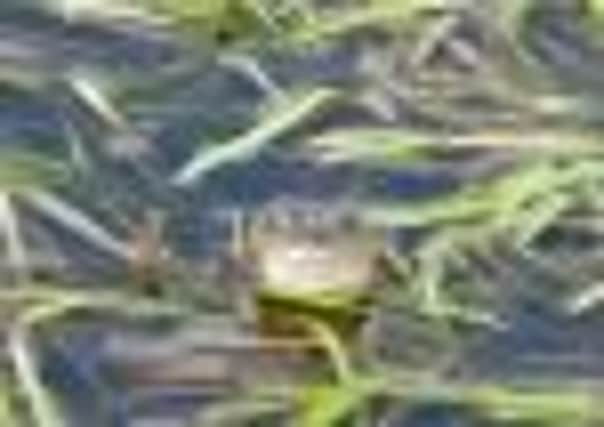Give nature a helping hand with a new plan for the back garden


With so many of our favourite birds and wild flowers declining in the wider countryside, gardens have never been so important to nature.
The Yorkshire Wildlife Trust argues that taken together they form important links between urban green spaces, nature reserves and the wider countryside.
Advertisement
Hide AdAdvertisement
Hide AdNow is the time to start – even a small back garden can become a green oasis.
Many of the birds we take for granted need our help, house sparrows, starlings and song thrushes in particular.
Peanuts, mixed seeds, fat balls and a source of water will lure them to your garden but don’t put all the food in hanging feeders.
Blue tits and other tits will appreciate it but blackbirds and robins will go hungry because they need to feed on the ground or from a stable bird table.
Advertisement
Hide AdAdvertisement
Hide AdFeeders and nest boxes are helpful but there’s a lot more that can be done. Modern gardens don’t always have what birds look for.
We tend to cut back bushes, remove trees in case they undermine a wall, and loathe undergrowth of any sort.
If you want to attract more birds, give some thought to getting the basics right.
Many birds look for a three-level garden. They need trees for observation posts, thick hedges or thorny bushes for cover, nesting and roosting, and ground-level feeding areas. A lawn with a single lofty tree is not enough. It is like a hotel with a ground floor and a roof terrace but nothing in between.
Advertisement
Hide AdAdvertisement
Hide AdAchieving the right balance of plants is the foundation for any wildlife garden. Cottage garden flowers can be a rich source of nectar for bees, butterflies and other insects.
Try Aubrieta and flowering currant in spring, lavender and buddleia in summer and stonecrop and Michaelmas daisy in autumn.
Make sure there is a good mix of native wild plants because they are the ones many insects prefer.
Sowing a meadow of mixed annual wild flowers like cornflowers, red poppies and field forget-me-nots can give quick results by creating a display of summer colours teeming with insect life.
Advertisement
Hide AdAdvertisement
Hide AdAn easier way of adding a little rough to the smooth is to allow the countryside to reclaim part of your garden itself, perhaps a lawn or even just a corner. Just let it grow.
To get faster results, add native wild flower plants like scabious, birdsfoot trefoil and salad burnet if your soil is lime-rich, or perhaps fox gloves and tormentil if your soil is more acid.
And if your ground is damp, why not bury some snakes-head fritillary bulbs in the autumn ready for next year?
Letting nature take over doesn’t mean your wild patch will look after itself.
Advertisement
Hide AdAdvertisement
Hide AdIt will benefit from being cut down to a height of four or five inches in September once everything has flowered and set seed and if any one plant looks like it’s taking over, creeping buttercup for example, intervene to restore the balance.
Stinging nettles are vital for stunning butterflies like the red admiral and peacock, while thistles provide seed for finches.
But few plants can match the wildlife value of the often maligned ivy.
It provides shelter for birds all year round, nest sites in spring, nectar-rich flowers for bees and berries for birds and small mammals in winter.
Advertisement
Hide AdAdvertisement
Hide AdEncourage hedgehogs with a loose pile of cuttings and branches in a quiet corner.
Slow worms will take up residence if you leave a mound of grass cuttings undisturbed in a sunny spot, and if you pile up some rocks next to it you could find lizards basking on them on hot days.
Over in the shade, a log pile makes a good home for small mammals like shrews as well as providing a place for beetles and centipedes.
And if you really want to push the boat out with your wildlife garden, think about a pond.
Advertisement
Hide AdAdvertisement
Hide AdEven a small one will reward you with dragonflies, damsel flies, frogs and newts. Just remember though that cats and frogs don’t mix.
There are other benefits too. With nature’s input, you’ll find that the whole garden works better.
Slug pellets can be toxic to wildlife and pets but if you manage to entice hedgehogs, frogs, toads or slow worms into your garden, they will eat the slugs for you anyway.
Hoverflies and ladybirds will help keep those aphids under control.
Advertisement
Hide AdAdvertisement
Hide AdThey are also excellent pollinators and with bees they will do their best to ensure you get a bumper crop of apples and other fruit.
And, can you imagine it, but swallows are happy to eat wasps for you.
In a living garden, everything becomes connected and it could well be to your advantage.
Lizzie Dealey of the Yorkshire Wildlife Trust, says: “You don’t have to spend a lot of money to improve your garden for wildlife.
“The simplest thing you can do is just not be over-tidy.
“Digging a pond yourself is time consuming but it doesn’t have to be expensive and through introducing wet conditions, it’s a great way of increasing diversity.”